Case Study Analysis: Jose's Mexican Restaurant - OPMT 3306
VerifiedAdded on 2022/12/26
|10
|2525
|61
Case Study
AI Summary
This case study examines Jose's Mexican Restaurant's operations, aiming to determine the feasibility of implementing ISO 9001:2015. The analysis begins with an internal and external PEST analysis, evaluating political, economic, social, and technological factors influencing the restaurant. It identifies key interested parties, including customers, suppliers, employees, and the government, and discusses their needs and expectations. A quality policy is proposed, aligning with ISO requirements. The assignment then addresses risk and opportunity management using the FMEA process, pinpointing potential failures and proposing improvements. Quality objectives and a corresponding plan are outlined. The study also analyzes customer satisfaction based on survey results, suggesting improvements. Finally, it provides recommendations for achieving ISO certification, including raw material control, process control, and proper coordination of food and services. The study emphasizes the importance of these quality management systems for improving the restaurant's competitiveness and customer satisfaction.

Case Study 1
Case Study
Case Study
Paraphrase This Document
Need a fresh take? Get an instant paraphrase of this document with our AI Paraphraser
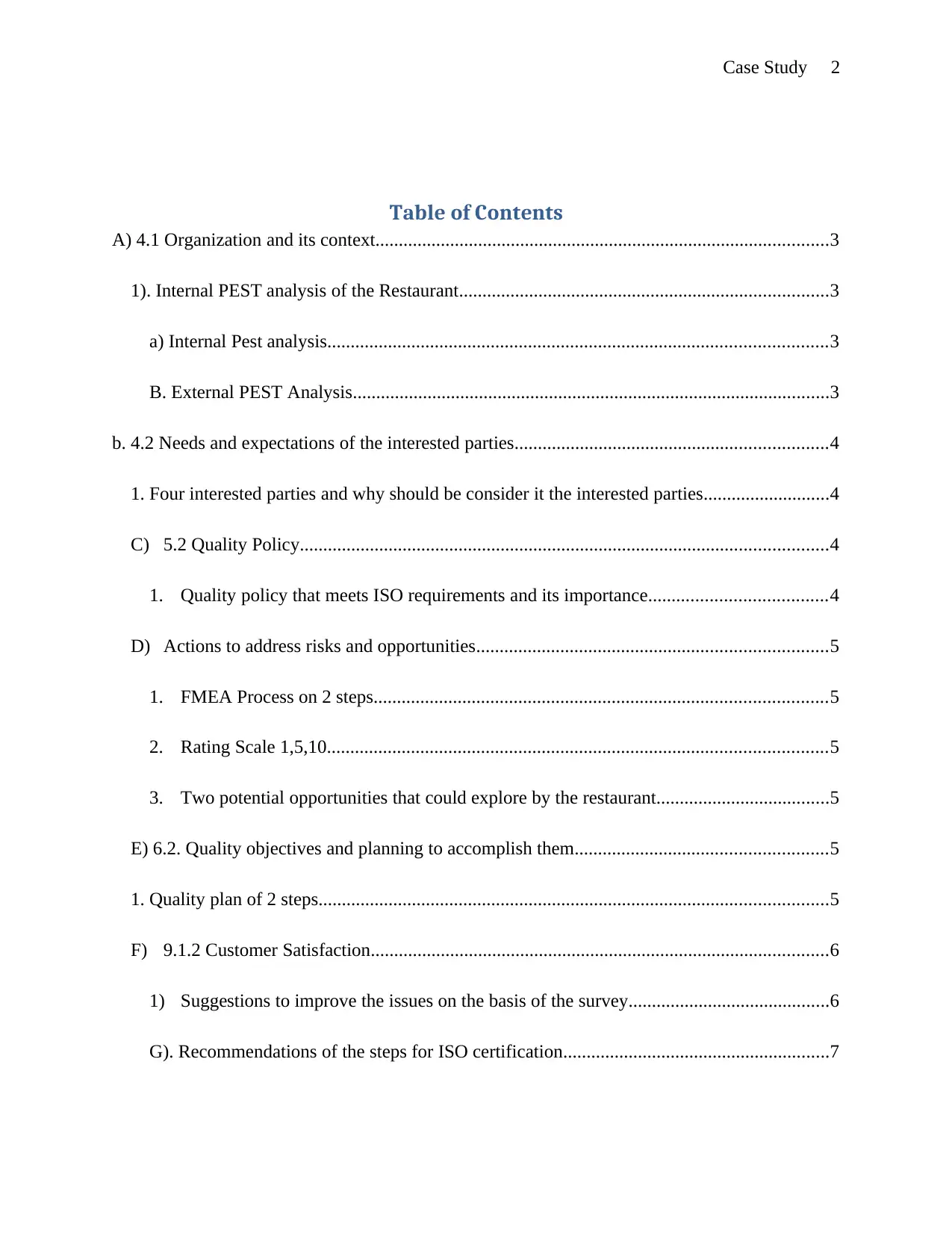
Case Study 2
Table of Contents
A) 4.1 Organization and its context.................................................................................................3
1). Internal PEST analysis of the Restaurant...............................................................................3
a) Internal Pest analysis...........................................................................................................3
B. External PEST Analysis......................................................................................................3
b. 4.2 Needs and expectations of the interested parties...................................................................4
1. Four interested parties and why should be consider it the interested parties...........................4
C) 5.2 Quality Policy.................................................................................................................4
1. Quality policy that meets ISO requirements and its importance......................................4
D) Actions to address risks and opportunities...........................................................................5
1. FMEA Process on 2 steps.................................................................................................5
2. Rating Scale 1,5,10...........................................................................................................5
3. Two potential opportunities that could explore by the restaurant.....................................5
E) 6.2. Quality objectives and planning to accomplish them......................................................5
1. Quality plan of 2 steps.............................................................................................................5
F) 9.1.2 Customer Satisfaction..................................................................................................6
1) Suggestions to improve the issues on the basis of the survey...........................................6
G). Recommendations of the steps for ISO certification.........................................................7
Table of Contents
A) 4.1 Organization and its context.................................................................................................3
1). Internal PEST analysis of the Restaurant...............................................................................3
a) Internal Pest analysis...........................................................................................................3
B. External PEST Analysis......................................................................................................3
b. 4.2 Needs and expectations of the interested parties...................................................................4
1. Four interested parties and why should be consider it the interested parties...........................4
C) 5.2 Quality Policy.................................................................................................................4
1. Quality policy that meets ISO requirements and its importance......................................4
D) Actions to address risks and opportunities...........................................................................5
1. FMEA Process on 2 steps.................................................................................................5
2. Rating Scale 1,5,10...........................................................................................................5
3. Two potential opportunities that could explore by the restaurant.....................................5
E) 6.2. Quality objectives and planning to accomplish them......................................................5
1. Quality plan of 2 steps.............................................................................................................5
F) 9.1.2 Customer Satisfaction..................................................................................................6
1) Suggestions to improve the issues on the basis of the survey...........................................6
G). Recommendations of the steps for ISO certification.........................................................7

Case Study 3
⊘ This is a preview!⊘
Do you want full access?
Subscribe today to unlock all pages.

Trusted by 1+ million students worldwide
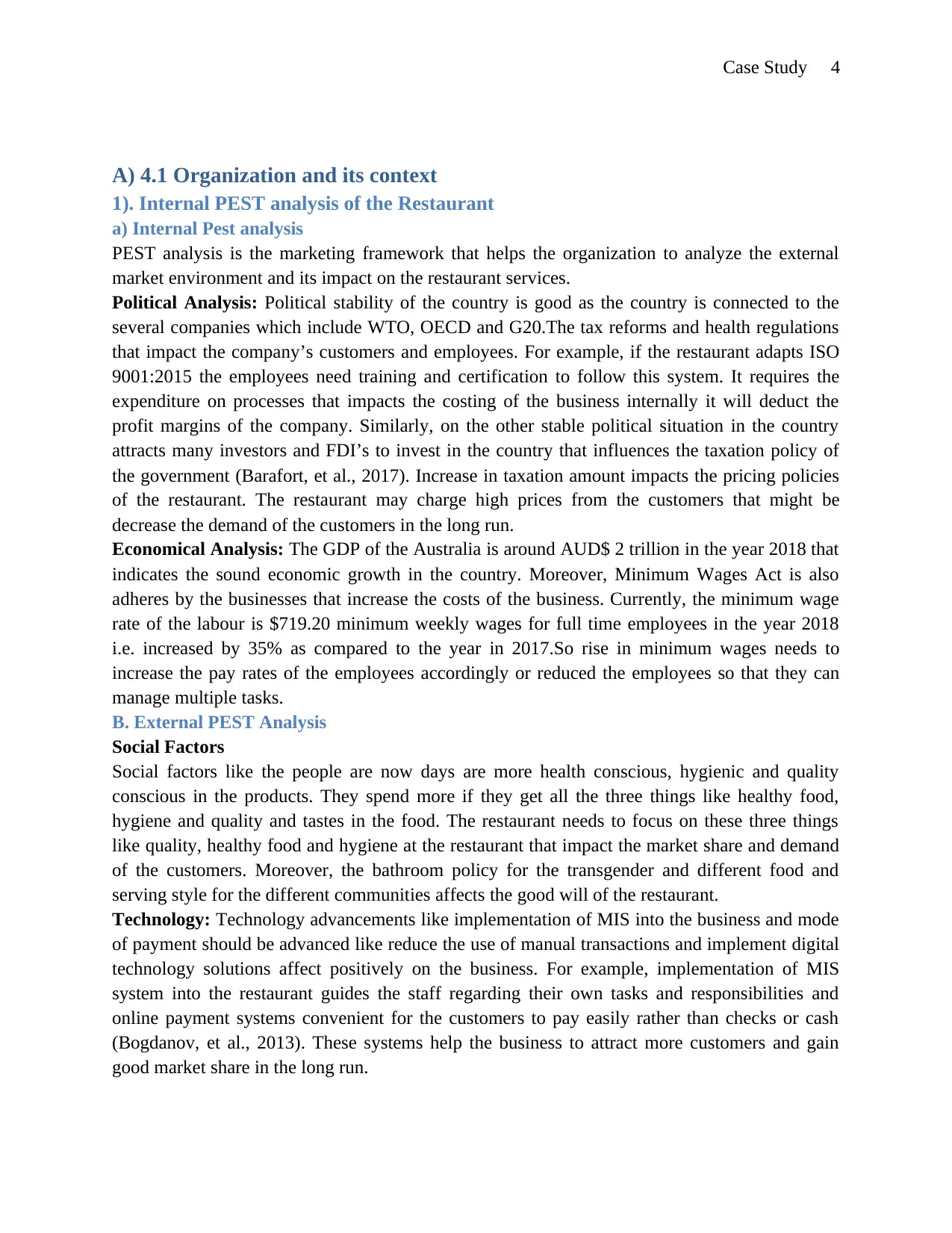
Case Study 4
A) 4.1 Organization and its context
1). Internal PEST analysis of the Restaurant
a) Internal Pest analysis
PEST analysis is the marketing framework that helps the organization to analyze the external
market environment and its impact on the restaurant services.
Political Analysis: Political stability of the country is good as the country is connected to the
several companies which include WTO, OECD and G20.The tax reforms and health regulations
that impact the company’s customers and employees. For example, if the restaurant adapts ISO
9001:2015 the employees need training and certification to follow this system. It requires the
expenditure on processes that impacts the costing of the business internally it will deduct the
profit margins of the company. Similarly, on the other stable political situation in the country
attracts many investors and FDI’s to invest in the country that influences the taxation policy of
the government (Barafort, et al., 2017). Increase in taxation amount impacts the pricing policies
of the restaurant. The restaurant may charge high prices from the customers that might be
decrease the demand of the customers in the long run.
Economical Analysis: The GDP of the Australia is around AUD$ 2 trillion in the year 2018 that
indicates the sound economic growth in the country. Moreover, Minimum Wages Act is also
adheres by the businesses that increase the costs of the business. Currently, the minimum wage
rate of the labour is $719.20 minimum weekly wages for full time employees in the year 2018
i.e. increased by 35% as compared to the year in 2017.So rise in minimum wages needs to
increase the pay rates of the employees accordingly or reduced the employees so that they can
manage multiple tasks.
B. External PEST Analysis
Social Factors
Social factors like the people are now days are more health conscious, hygienic and quality
conscious in the products. They spend more if they get all the three things like healthy food,
hygiene and quality and tastes in the food. The restaurant needs to focus on these three things
like quality, healthy food and hygiene at the restaurant that impact the market share and demand
of the customers. Moreover, the bathroom policy for the transgender and different food and
serving style for the different communities affects the good will of the restaurant.
Technology: Technology advancements like implementation of MIS into the business and mode
of payment should be advanced like reduce the use of manual transactions and implement digital
technology solutions affect positively on the business. For example, implementation of MIS
system into the restaurant guides the staff regarding their own tasks and responsibilities and
online payment systems convenient for the customers to pay easily rather than checks or cash
(Bogdanov, et al., 2013). These systems help the business to attract more customers and gain
good market share in the long run.
A) 4.1 Organization and its context
1). Internal PEST analysis of the Restaurant
a) Internal Pest analysis
PEST analysis is the marketing framework that helps the organization to analyze the external
market environment and its impact on the restaurant services.
Political Analysis: Political stability of the country is good as the country is connected to the
several companies which include WTO, OECD and G20.The tax reforms and health regulations
that impact the company’s customers and employees. For example, if the restaurant adapts ISO
9001:2015 the employees need training and certification to follow this system. It requires the
expenditure on processes that impacts the costing of the business internally it will deduct the
profit margins of the company. Similarly, on the other stable political situation in the country
attracts many investors and FDI’s to invest in the country that influences the taxation policy of
the government (Barafort, et al., 2017). Increase in taxation amount impacts the pricing policies
of the restaurant. The restaurant may charge high prices from the customers that might be
decrease the demand of the customers in the long run.
Economical Analysis: The GDP of the Australia is around AUD$ 2 trillion in the year 2018 that
indicates the sound economic growth in the country. Moreover, Minimum Wages Act is also
adheres by the businesses that increase the costs of the business. Currently, the minimum wage
rate of the labour is $719.20 minimum weekly wages for full time employees in the year 2018
i.e. increased by 35% as compared to the year in 2017.So rise in minimum wages needs to
increase the pay rates of the employees accordingly or reduced the employees so that they can
manage multiple tasks.
B. External PEST Analysis
Social Factors
Social factors like the people are now days are more health conscious, hygienic and quality
conscious in the products. They spend more if they get all the three things like healthy food,
hygiene and quality and tastes in the food. The restaurant needs to focus on these three things
like quality, healthy food and hygiene at the restaurant that impact the market share and demand
of the customers. Moreover, the bathroom policy for the transgender and different food and
serving style for the different communities affects the good will of the restaurant.
Technology: Technology advancements like implementation of MIS into the business and mode
of payment should be advanced like reduce the use of manual transactions and implement digital
technology solutions affect positively on the business. For example, implementation of MIS
system into the restaurant guides the staff regarding their own tasks and responsibilities and
online payment systems convenient for the customers to pay easily rather than checks or cash
(Bogdanov, et al., 2013). These systems help the business to attract more customers and gain
good market share in the long run.
Paraphrase This Document
Need a fresh take? Get an instant paraphrase of this document with our AI Paraphraser
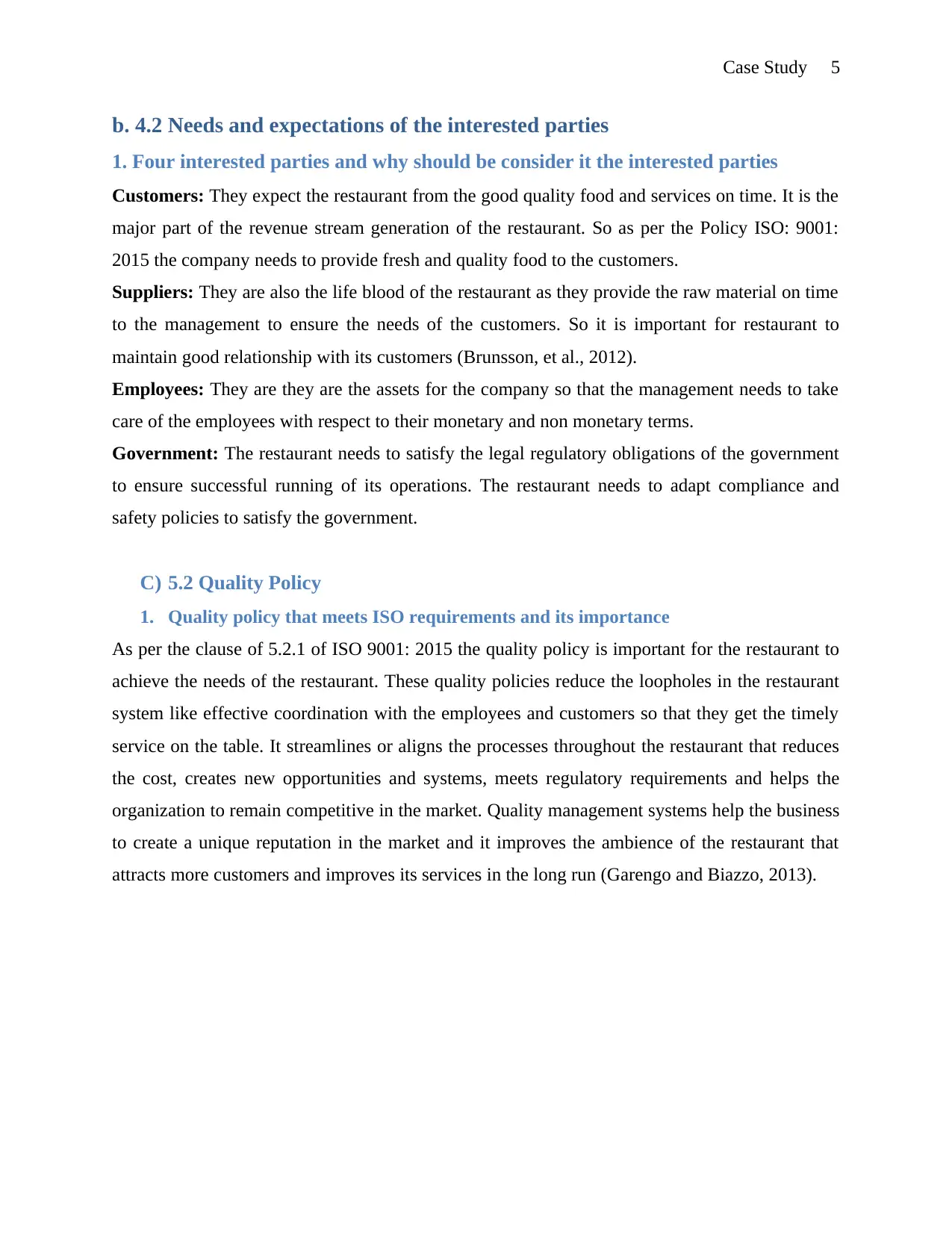
Case Study 5
b. 4.2 Needs and expectations of the interested parties
1. Four interested parties and why should be consider it the interested parties
Customers: They expect the restaurant from the good quality food and services on time. It is the
major part of the revenue stream generation of the restaurant. So as per the Policy ISO: 9001:
2015 the company needs to provide fresh and quality food to the customers.
Suppliers: They are also the life blood of the restaurant as they provide the raw material on time
to the management to ensure the needs of the customers. So it is important for restaurant to
maintain good relationship with its customers (Brunsson, et al., 2012).
Employees: They are they are the assets for the company so that the management needs to take
care of the employees with respect to their monetary and non monetary terms.
Government: The restaurant needs to satisfy the legal regulatory obligations of the government
to ensure successful running of its operations. The restaurant needs to adapt compliance and
safety policies to satisfy the government.
C) 5.2 Quality Policy
1. Quality policy that meets ISO requirements and its importance
As per the clause of 5.2.1 of ISO 9001: 2015 the quality policy is important for the restaurant to
achieve the needs of the restaurant. These quality policies reduce the loopholes in the restaurant
system like effective coordination with the employees and customers so that they get the timely
service on the table. It streamlines or aligns the processes throughout the restaurant that reduces
the cost, creates new opportunities and systems, meets regulatory requirements and helps the
organization to remain competitive in the market. Quality management systems help the business
to create a unique reputation in the market and it improves the ambience of the restaurant that
attracts more customers and improves its services in the long run (Garengo and Biazzo, 2013).
b. 4.2 Needs and expectations of the interested parties
1. Four interested parties and why should be consider it the interested parties
Customers: They expect the restaurant from the good quality food and services on time. It is the
major part of the revenue stream generation of the restaurant. So as per the Policy ISO: 9001:
2015 the company needs to provide fresh and quality food to the customers.
Suppliers: They are also the life blood of the restaurant as they provide the raw material on time
to the management to ensure the needs of the customers. So it is important for restaurant to
maintain good relationship with its customers (Brunsson, et al., 2012).
Employees: They are they are the assets for the company so that the management needs to take
care of the employees with respect to their monetary and non monetary terms.
Government: The restaurant needs to satisfy the legal regulatory obligations of the government
to ensure successful running of its operations. The restaurant needs to adapt compliance and
safety policies to satisfy the government.
C) 5.2 Quality Policy
1. Quality policy that meets ISO requirements and its importance
As per the clause of 5.2.1 of ISO 9001: 2015 the quality policy is important for the restaurant to
achieve the needs of the restaurant. These quality policies reduce the loopholes in the restaurant
system like effective coordination with the employees and customers so that they get the timely
service on the table. It streamlines or aligns the processes throughout the restaurant that reduces
the cost, creates new opportunities and systems, meets regulatory requirements and helps the
organization to remain competitive in the market. Quality management systems help the business
to create a unique reputation in the market and it improves the ambience of the restaurant that
attracts more customers and improves its services in the long run (Garengo and Biazzo, 2013).
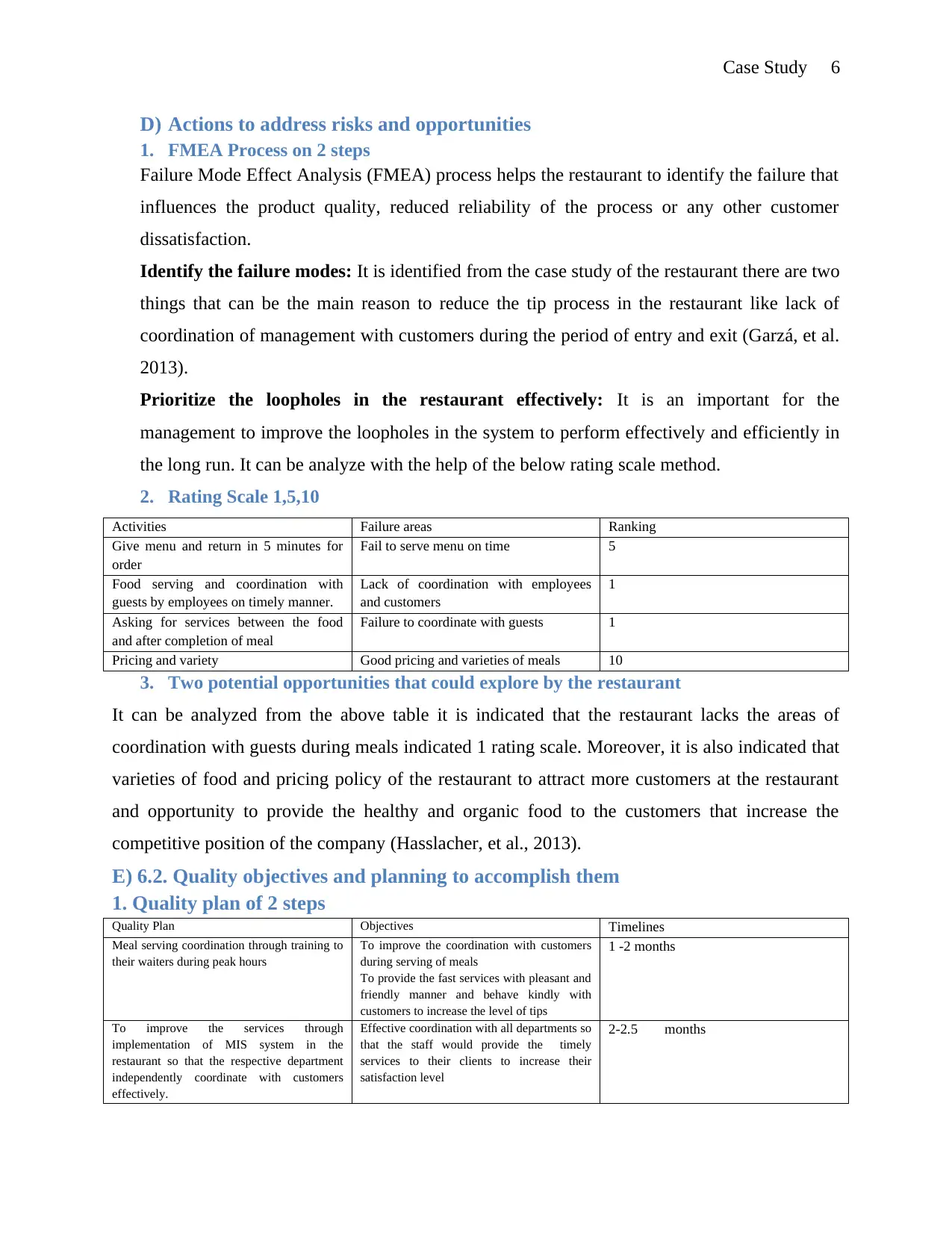
Case Study 6
D) Actions to address risks and opportunities
1. FMEA Process on 2 steps
Failure Mode Effect Analysis (FMEA) process helps the restaurant to identify the failure that
influences the product quality, reduced reliability of the process or any other customer
dissatisfaction.
Identify the failure modes: It is identified from the case study of the restaurant there are two
things that can be the main reason to reduce the tip process in the restaurant like lack of
coordination of management with customers during the period of entry and exit (Garzá, et al.
2013).
Prioritize the loopholes in the restaurant effectively: It is an important for the
management to improve the loopholes in the system to perform effectively and efficiently in
the long run. It can be analyze with the help of the below rating scale method.
2. Rating Scale 1,5,10
Activities Failure areas Ranking
Give menu and return in 5 minutes for
order
Fail to serve menu on time 5
Food serving and coordination with
guests by employees on timely manner.
Lack of coordination with employees
and customers
1
Asking for services between the food
and after completion of meal
Failure to coordinate with guests 1
Pricing and variety Good pricing and varieties of meals 10
3. Two potential opportunities that could explore by the restaurant
It can be analyzed from the above table it is indicated that the restaurant lacks the areas of
coordination with guests during meals indicated 1 rating scale. Moreover, it is also indicated that
varieties of food and pricing policy of the restaurant to attract more customers at the restaurant
and opportunity to provide the healthy and organic food to the customers that increase the
competitive position of the company (Hasslacher, et al., 2013).
E) 6.2. Quality objectives and planning to accomplish them
1. Quality plan of 2 steps
Quality Plan Objectives Timelines
Meal serving coordination through training to
their waiters during peak hours
To improve the coordination with customers
during serving of meals
To provide the fast services with pleasant and
friendly manner and behave kindly with
customers to increase the level of tips
1 -2 months
To improve the services through
implementation of MIS system in the
restaurant so that the respective department
independently coordinate with customers
effectively.
Effective coordination with all departments so
that the staff would provide the timely
services to their clients to increase their
satisfaction level
2-2.5 months
D) Actions to address risks and opportunities
1. FMEA Process on 2 steps
Failure Mode Effect Analysis (FMEA) process helps the restaurant to identify the failure that
influences the product quality, reduced reliability of the process or any other customer
dissatisfaction.
Identify the failure modes: It is identified from the case study of the restaurant there are two
things that can be the main reason to reduce the tip process in the restaurant like lack of
coordination of management with customers during the period of entry and exit (Garzá, et al.
2013).
Prioritize the loopholes in the restaurant effectively: It is an important for the
management to improve the loopholes in the system to perform effectively and efficiently in
the long run. It can be analyze with the help of the below rating scale method.
2. Rating Scale 1,5,10
Activities Failure areas Ranking
Give menu and return in 5 minutes for
order
Fail to serve menu on time 5
Food serving and coordination with
guests by employees on timely manner.
Lack of coordination with employees
and customers
1
Asking for services between the food
and after completion of meal
Failure to coordinate with guests 1
Pricing and variety Good pricing and varieties of meals 10
3. Two potential opportunities that could explore by the restaurant
It can be analyzed from the above table it is indicated that the restaurant lacks the areas of
coordination with guests during meals indicated 1 rating scale. Moreover, it is also indicated that
varieties of food and pricing policy of the restaurant to attract more customers at the restaurant
and opportunity to provide the healthy and organic food to the customers that increase the
competitive position of the company (Hasslacher, et al., 2013).
E) 6.2. Quality objectives and planning to accomplish them
1. Quality plan of 2 steps
Quality Plan Objectives Timelines
Meal serving coordination through training to
their waiters during peak hours
To improve the coordination with customers
during serving of meals
To provide the fast services with pleasant and
friendly manner and behave kindly with
customers to increase the level of tips
1 -2 months
To improve the services through
implementation of MIS system in the
restaurant so that the respective department
independently coordinate with customers
effectively.
Effective coordination with all departments so
that the staff would provide the timely
services to their clients to increase their
satisfaction level
2-2.5 months
⊘ This is a preview!⊘
Do you want full access?
Subscribe today to unlock all pages.

Trusted by 1+ million students worldwide
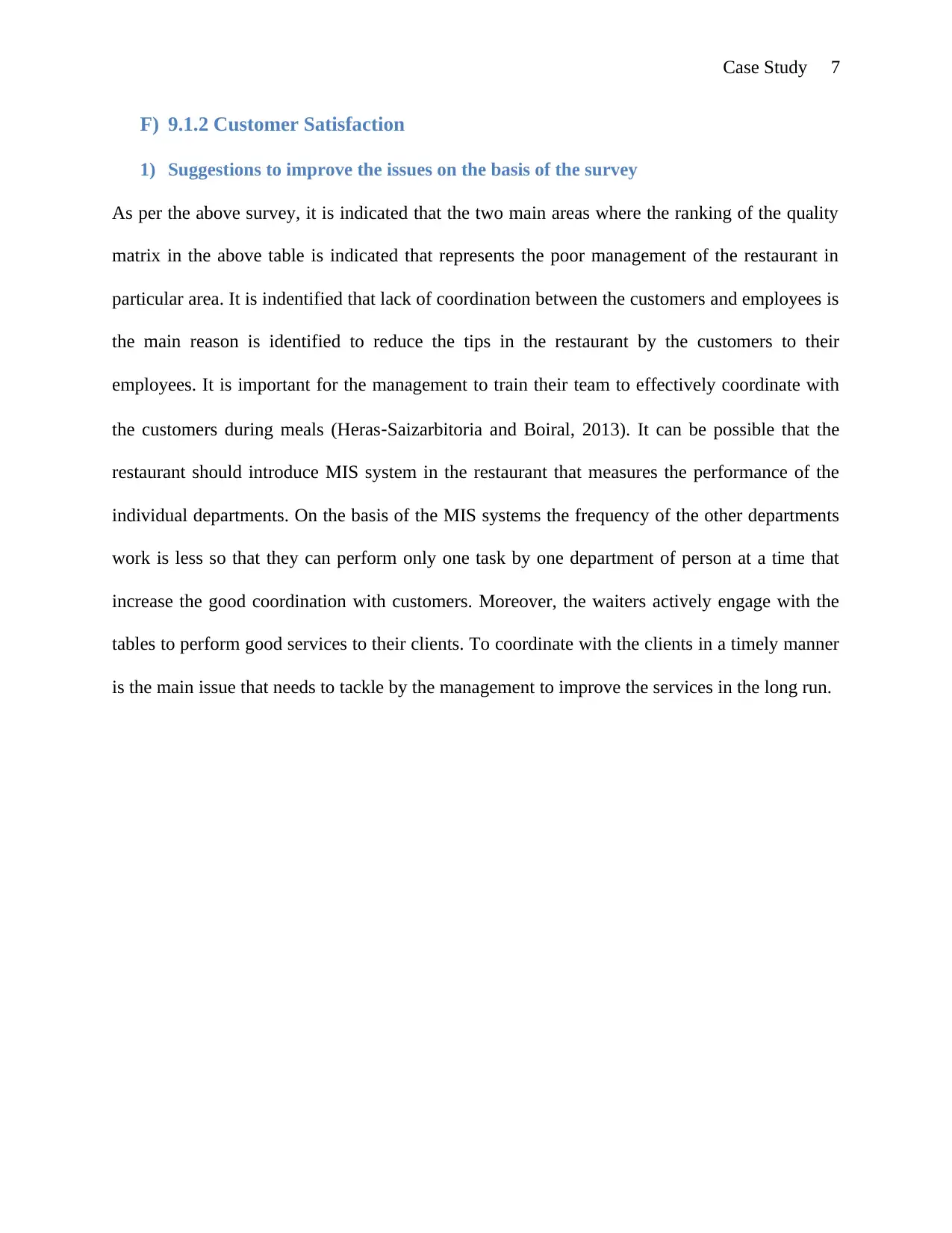
Case Study 7
F) 9.1.2 Customer Satisfaction
1) Suggestions to improve the issues on the basis of the survey
As per the above survey, it is indicated that the two main areas where the ranking of the quality
matrix in the above table is indicated that represents the poor management of the restaurant in
particular area. It is indentified that lack of coordination between the customers and employees is
the main reason is identified to reduce the tips in the restaurant by the customers to their
employees. It is important for the management to train their team to effectively coordinate with
the customers during meals (Heras‐Saizarbitoria and Boiral, 2013). It can be possible that the
restaurant should introduce MIS system in the restaurant that measures the performance of the
individual departments. On the basis of the MIS systems the frequency of the other departments
work is less so that they can perform only one task by one department of person at a time that
increase the good coordination with customers. Moreover, the waiters actively engage with the
tables to perform good services to their clients. To coordinate with the clients in a timely manner
is the main issue that needs to tackle by the management to improve the services in the long run.
F) 9.1.2 Customer Satisfaction
1) Suggestions to improve the issues on the basis of the survey
As per the above survey, it is indicated that the two main areas where the ranking of the quality
matrix in the above table is indicated that represents the poor management of the restaurant in
particular area. It is indentified that lack of coordination between the customers and employees is
the main reason is identified to reduce the tips in the restaurant by the customers to their
employees. It is important for the management to train their team to effectively coordinate with
the customers during meals (Heras‐Saizarbitoria and Boiral, 2013). It can be possible that the
restaurant should introduce MIS system in the restaurant that measures the performance of the
individual departments. On the basis of the MIS systems the frequency of the other departments
work is less so that they can perform only one task by one department of person at a time that
increase the good coordination with customers. Moreover, the waiters actively engage with the
tables to perform good services to their clients. To coordinate with the clients in a timely manner
is the main issue that needs to tackle by the management to improve the services in the long run.
Paraphrase This Document
Need a fresh take? Get an instant paraphrase of this document with our AI Paraphraser
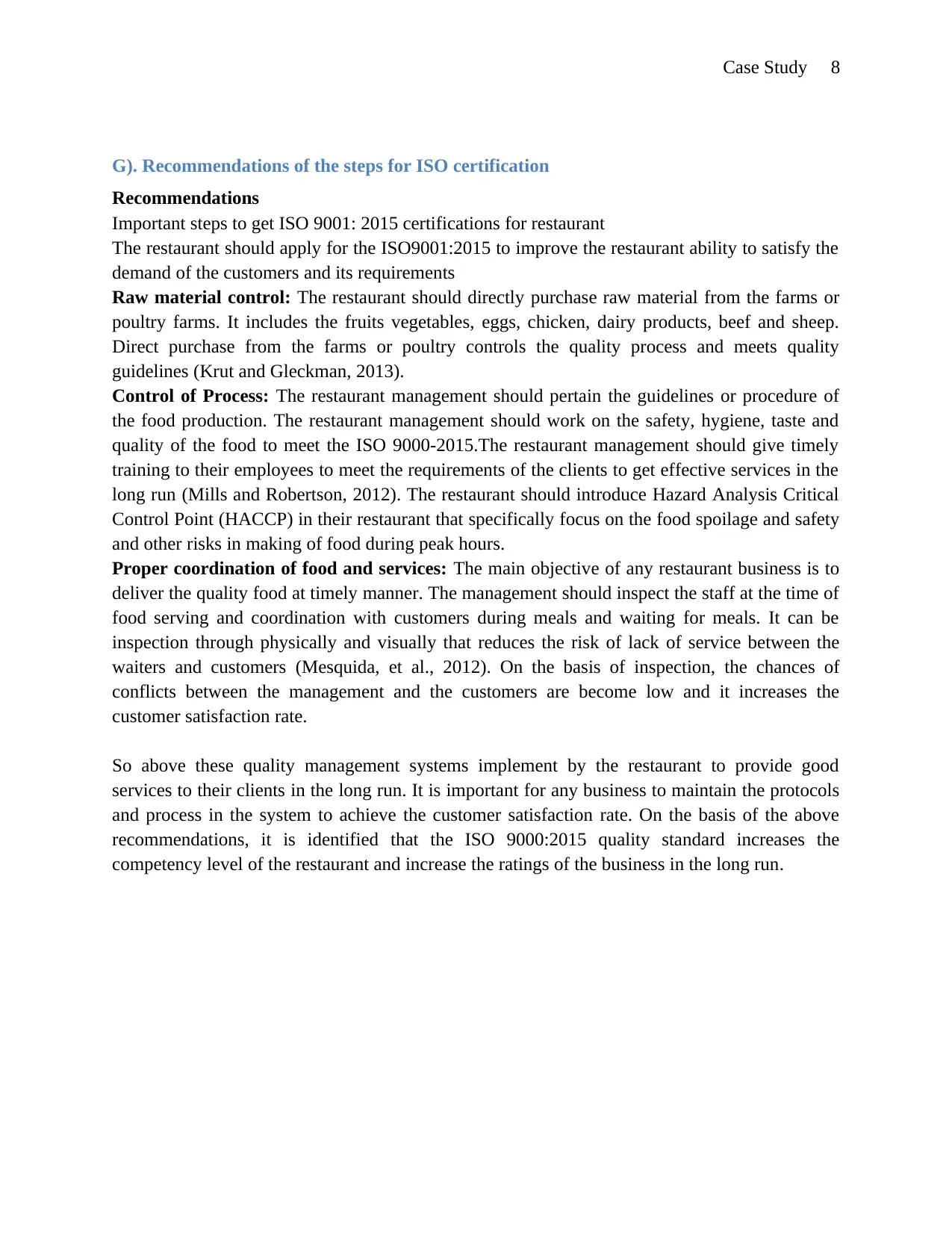
Case Study 8
G). Recommendations of the steps for ISO certification
Recommendations
Important steps to get ISO 9001: 2015 certifications for restaurant
The restaurant should apply for the ISO9001:2015 to improve the restaurant ability to satisfy the
demand of the customers and its requirements
Raw material control: The restaurant should directly purchase raw material from the farms or
poultry farms. It includes the fruits vegetables, eggs, chicken, dairy products, beef and sheep.
Direct purchase from the farms or poultry controls the quality process and meets quality
guidelines (Krut and Gleckman, 2013).
Control of Process: The restaurant management should pertain the guidelines or procedure of
the food production. The restaurant management should work on the safety, hygiene, taste and
quality of the food to meet the ISO 9000-2015.The restaurant management should give timely
training to their employees to meet the requirements of the clients to get effective services in the
long run (Mills and Robertson, 2012). The restaurant should introduce Hazard Analysis Critical
Control Point (HACCP) in their restaurant that specifically focus on the food spoilage and safety
and other risks in making of food during peak hours.
Proper coordination of food and services: The main objective of any restaurant business is to
deliver the quality food at timely manner. The management should inspect the staff at the time of
food serving and coordination with customers during meals and waiting for meals. It can be
inspection through physically and visually that reduces the risk of lack of service between the
waiters and customers (Mesquida, et al., 2012). On the basis of inspection, the chances of
conflicts between the management and the customers are become low and it increases the
customer satisfaction rate.
So above these quality management systems implement by the restaurant to provide good
services to their clients in the long run. It is important for any business to maintain the protocols
and process in the system to achieve the customer satisfaction rate. On the basis of the above
recommendations, it is identified that the ISO 9000:2015 quality standard increases the
competency level of the restaurant and increase the ratings of the business in the long run.
G). Recommendations of the steps for ISO certification
Recommendations
Important steps to get ISO 9001: 2015 certifications for restaurant
The restaurant should apply for the ISO9001:2015 to improve the restaurant ability to satisfy the
demand of the customers and its requirements
Raw material control: The restaurant should directly purchase raw material from the farms or
poultry farms. It includes the fruits vegetables, eggs, chicken, dairy products, beef and sheep.
Direct purchase from the farms or poultry controls the quality process and meets quality
guidelines (Krut and Gleckman, 2013).
Control of Process: The restaurant management should pertain the guidelines or procedure of
the food production. The restaurant management should work on the safety, hygiene, taste and
quality of the food to meet the ISO 9000-2015.The restaurant management should give timely
training to their employees to meet the requirements of the clients to get effective services in the
long run (Mills and Robertson, 2012). The restaurant should introduce Hazard Analysis Critical
Control Point (HACCP) in their restaurant that specifically focus on the food spoilage and safety
and other risks in making of food during peak hours.
Proper coordination of food and services: The main objective of any restaurant business is to
deliver the quality food at timely manner. The management should inspect the staff at the time of
food serving and coordination with customers during meals and waiting for meals. It can be
inspection through physically and visually that reduces the risk of lack of service between the
waiters and customers (Mesquida, et al., 2012). On the basis of inspection, the chances of
conflicts between the management and the customers are become low and it increases the
customer satisfaction rate.
So above these quality management systems implement by the restaurant to provide good
services to their clients in the long run. It is important for any business to maintain the protocols
and process in the system to achieve the customer satisfaction rate. On the basis of the above
recommendations, it is identified that the ISO 9000:2015 quality standard increases the
competency level of the restaurant and increase the ratings of the business in the long run.
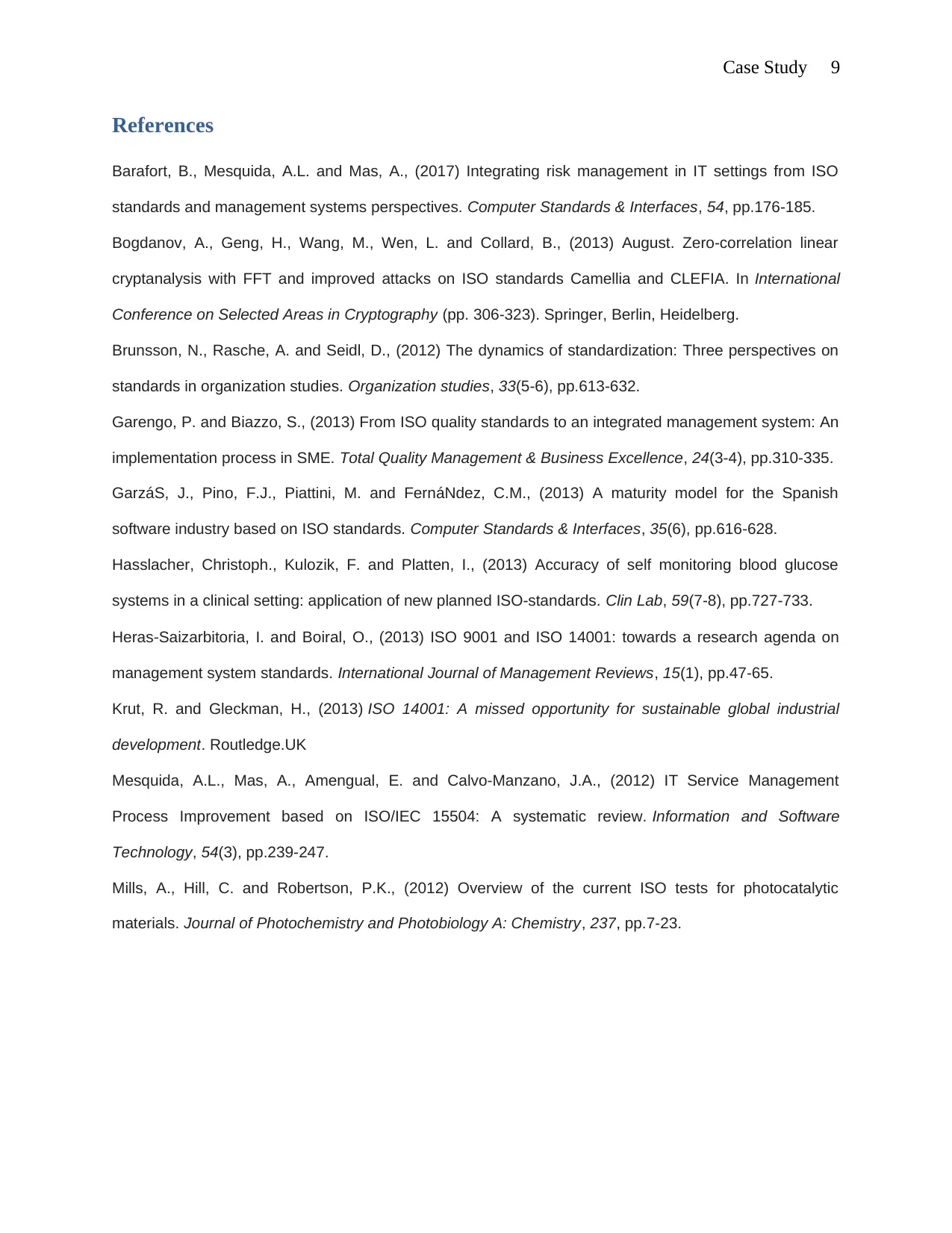
Case Study 9
References
Barafort, B., Mesquida, A.L. and Mas, A., (2017) Integrating risk management in IT settings from ISO
standards and management systems perspectives. Computer Standards & Interfaces, 54, pp.176-185.
Bogdanov, A., Geng, H., Wang, M., Wen, L. and Collard, B., (2013) August. Zero-correlation linear
cryptanalysis with FFT and improved attacks on ISO standards Camellia and CLEFIA. In International
Conference on Selected Areas in Cryptography (pp. 306-323). Springer, Berlin, Heidelberg.
Brunsson, N., Rasche, A. and Seidl, D., (2012) The dynamics of standardization: Three perspectives on
standards in organization studies. Organization studies, 33(5-6), pp.613-632.
Garengo, P. and Biazzo, S., (2013) From ISO quality standards to an integrated management system: An
implementation process in SME. Total Quality Management & Business Excellence, 24(3-4), pp.310-335.
GarzáS, J., Pino, F.J., Piattini, M. and FernáNdez, C.M., (2013) A maturity model for the Spanish
software industry based on ISO standards. Computer Standards & Interfaces, 35(6), pp.616-628.
Hasslacher, Christoph., Kulozik, F. and Platten, I., (2013) Accuracy of self monitoring blood glucose
systems in a clinical setting: application of new planned ISO-standards. Clin Lab, 59(7-8), pp.727-733.
Heras‐Saizarbitoria, I. and Boiral, O., (2013) ISO 9001 and ISO 14001: towards a research agenda on
management system standards. International Journal of Management Reviews, 15(1), pp.47-65.
Krut, R. and Gleckman, H., (2013) ISO 14001: A missed opportunity for sustainable global industrial
development. Routledge.UK
Mesquida, A.L., Mas, A., Amengual, E. and Calvo-Manzano, J.A., (2012) IT Service Management
Process Improvement based on ISO/IEC 15504: A systematic review. Information and Software
Technology, 54(3), pp.239-247.
Mills, A., Hill, C. and Robertson, P.K., (2012) Overview of the current ISO tests for photocatalytic
materials. Journal of Photochemistry and Photobiology A: Chemistry, 237, pp.7-23.
References
Barafort, B., Mesquida, A.L. and Mas, A., (2017) Integrating risk management in IT settings from ISO
standards and management systems perspectives. Computer Standards & Interfaces, 54, pp.176-185.
Bogdanov, A., Geng, H., Wang, M., Wen, L. and Collard, B., (2013) August. Zero-correlation linear
cryptanalysis with FFT and improved attacks on ISO standards Camellia and CLEFIA. In International
Conference on Selected Areas in Cryptography (pp. 306-323). Springer, Berlin, Heidelberg.
Brunsson, N., Rasche, A. and Seidl, D., (2012) The dynamics of standardization: Three perspectives on
standards in organization studies. Organization studies, 33(5-6), pp.613-632.
Garengo, P. and Biazzo, S., (2013) From ISO quality standards to an integrated management system: An
implementation process in SME. Total Quality Management & Business Excellence, 24(3-4), pp.310-335.
GarzáS, J., Pino, F.J., Piattini, M. and FernáNdez, C.M., (2013) A maturity model for the Spanish
software industry based on ISO standards. Computer Standards & Interfaces, 35(6), pp.616-628.
Hasslacher, Christoph., Kulozik, F. and Platten, I., (2013) Accuracy of self monitoring blood glucose
systems in a clinical setting: application of new planned ISO-standards. Clin Lab, 59(7-8), pp.727-733.
Heras‐Saizarbitoria, I. and Boiral, O., (2013) ISO 9001 and ISO 14001: towards a research agenda on
management system standards. International Journal of Management Reviews, 15(1), pp.47-65.
Krut, R. and Gleckman, H., (2013) ISO 14001: A missed opportunity for sustainable global industrial
development. Routledge.UK
Mesquida, A.L., Mas, A., Amengual, E. and Calvo-Manzano, J.A., (2012) IT Service Management
Process Improvement based on ISO/IEC 15504: A systematic review. Information and Software
Technology, 54(3), pp.239-247.
Mills, A., Hill, C. and Robertson, P.K., (2012) Overview of the current ISO tests for photocatalytic
materials. Journal of Photochemistry and Photobiology A: Chemistry, 237, pp.7-23.
⊘ This is a preview!⊘
Do you want full access?
Subscribe today to unlock all pages.

Trusted by 1+ million students worldwide

Case Study 10
1 out of 10
Related Documents
Your All-in-One AI-Powered Toolkit for Academic Success.
+13062052269
info@desklib.com
Available 24*7 on WhatsApp / Email
![[object Object]](/_next/static/media/star-bottom.7253800d.svg)
Unlock your academic potential
Copyright © 2020–2025 A2Z Services. All Rights Reserved. Developed and managed by ZUCOL.





